Lindsay Grace is a video game designer, artist, and a professor. He’s best known as an academic gamer because of his focus on uses of interactive media and games to not only explore worlds but also cultural standards. His work includes projects such as social impact games, which are games that try to affect the gamers perspective about an issue, and much more. I think what he does effectively in his presentation is draw from different projects he’s worked on and the true data he shows with it.
Month: October 2020
Looking Outwards Individuals
The artist I will be looking at is Alexander Chen. His artistic mission is to illustrate the correlations between visual art, music, and life. He creates visualizations of music he loves, and conversely, he turns visual images (like the subway map of NYC) into music. He is currently located in Massachusetts and working as a creative director at Google. I admire the subjectivity of his work, and his clear love for both mediums. I agree that visual and audial experiences go hand in hand, and it’s always amazing to me to see how other people interact with the same music differently from me. I particularly love his project turning the NYC subway into a string instrument because I’m from New York and it brings me close to home. Alexander is a capable speaker because he plays to his audience, he uses pauses and silence to pace his speech in a palatable way, and he is confident in and passionate about the work he’s speaking about.
https://www.chenalexander.com/Bio
Looking Outwards-08 : Mike Tucker
Mike Tucker is an interactive director whose work focuses on how arts and music can be turned interactive. He is based in the UK, and he studied how to create interactive art. Mike Tucker currently works at Magic Leap, but he has worked with many bands to create interactive art that played their music, such as pulling spheres to your ear virtually, or creating little organisms that would chime with noise. He described himself as a big fan of Flash, before Steve Jobs had gotten rid of it with the development of Macintosh.
His work centers around using body motions, such as hands, eye movement, and head movement to direct art virtually. I admire how he tries to incorporate all five senses, and has made work that people had experienced synthesia with. I admire this because I tend to be sensitive to my senses, and end up focusing on certain noises or sights, and he effectively uses these traits to create art.
I admire his Tonandi work the most, because something about it seems very ethereal. There are glowing lights that sway with the sound and the head movement of the VR set, and it almost feels like you are in the movie, Avatar. Additionally, I think this work is special because though there are ethereal images appearing, the background can be anything, and it will make the user feel that they are in a different landscape. It gives off fairy-like vibes, and it is visually and audibly beautiful.
Mike Tucker presented his work very effectively, by going through timelines and comparisons. He first started by showing how VR once looked like before the technological advancements we have today, and then slowly showed how it changed with time. On top of this, he continuously showed the audience his work, and examples of how a user could interact with VR. For example, one of the works made it possible to “grab” a sphere with a song playing, and hold it to your ear to increase the volume. Another example was where the user’s fingertip could be used to draw different geometric shapes. It was impressive to see how the interactive media progressed as technology improved, and how Mike Tucker’s work grew with the time. From Mike Tucker, I got a sense of what a good presentation would be for artistic and technological projects like his. I would definitely present progress pictures/videos, and show examples of my inspiration like he did.
https://vimeo.com/channels/eyeo2019/page:4
The link above is the link to his talk. However I could not find a video of his work, Tonandi. Therefore, below includes pictures of Tonandi.

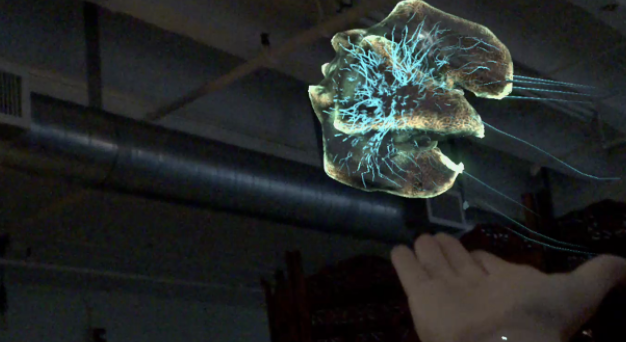
LO – 08
I watched the video on Sarah Groff Hennigh-Palermo from the 2019 Eyeo Festival. Hennigh-Palermo is an artist, data designer, and programmer.
Sarah’s work is devoted to making computers more accessible, flexible, and contextual; to do so she has created art sites, computer langugaes, hybrid machines, and — more recently — films and live visuals.
My personal favorite of her works is “Summer’91” which is based off her own experiences, specifically her childhood growing up in Southern California. I really like this piece because of its smooth visual flow with the warm tones, also once you know the story behind it you feel immersed in the gentle feeling from the piece.
I really like how she also pulls her own experiences into the presentation too. While presenting she often refered to what she has experienced to bring importance to her points.
In addition, her visuals are fun and intriguing making it easy for the viewers to feel engaged and intersted in her presentation.
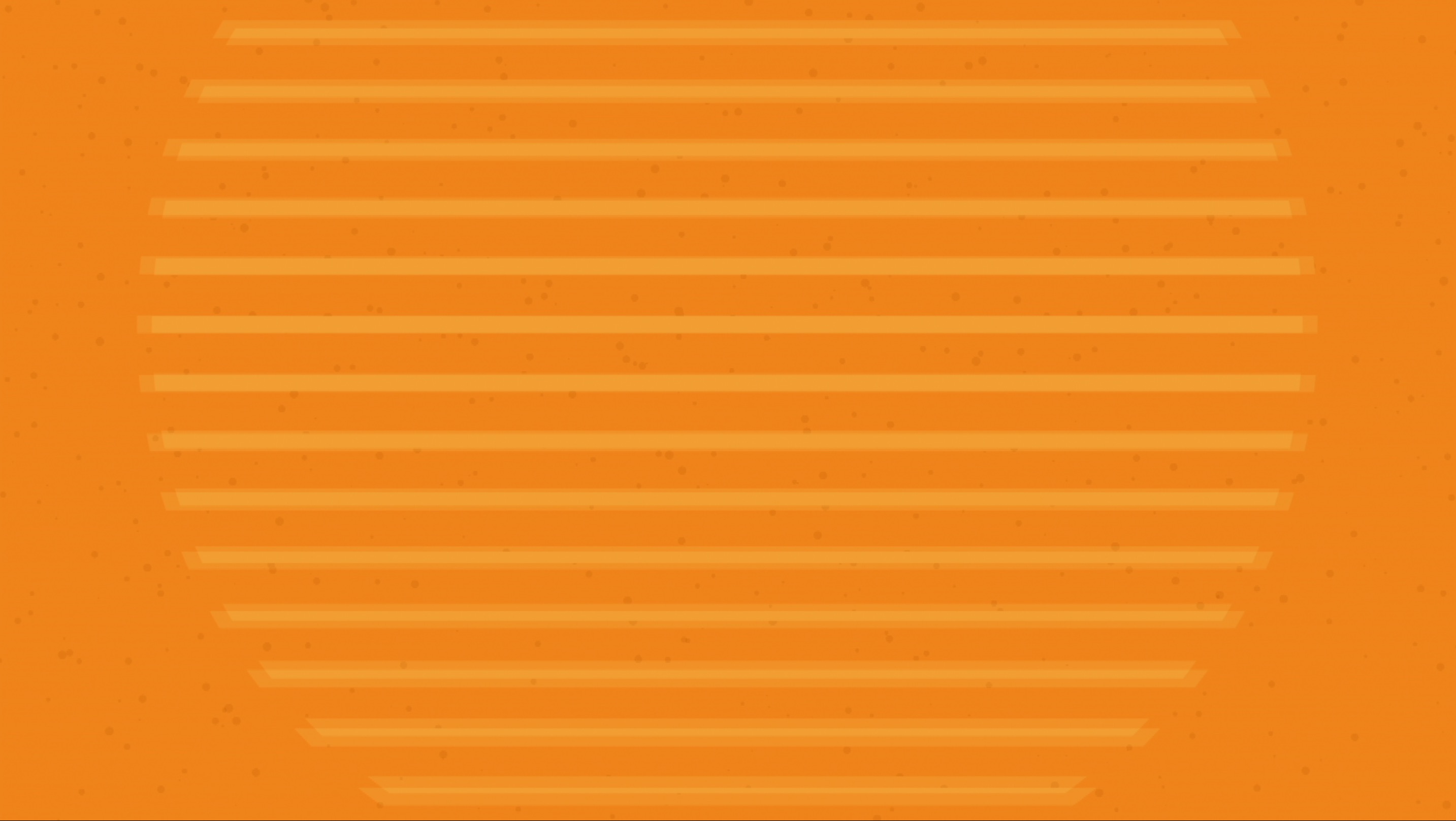
LO: “Not the Only One”
Stephanie Dinkins is a transdisciplinary (and transmedia) artist that explores the intersectionality between creating visual artifacts pushing the boundaries of AI/computer software and using these tools to create real-life solutions in confronting race and gender induced biases found in our daily lives. In addressing issues like social equity and data sovereignty in her work, Dinkins has actively engaged with communities of color to amplify and highlight the richness of culture and history found with these marginalized people.
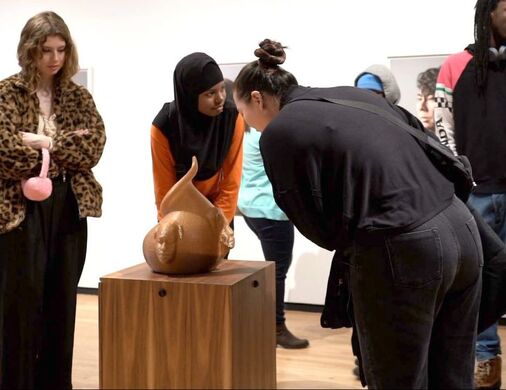
In one of her recent works, Not the Only One (N’TOO), Dinkins looked to incorporating Deep Learning algorithms and computer AI to create an interactive sculpture piece that communicates with users. N’TOO responds to spoken word questions, formulating answers from a large and rich database of history from three generations of Black women (from one family). Given the context of knowledge N’TOO has ‘learned’ from, Dinkins hopes to explicitly contribute to building communal nuance and transparency for those that are underrepresented in the tech sector, being women and members of the BIPOC community.
When looking at the broader scale of Dinkins’ work, I admire the nuanced methods of how she is able to communicate and build a narrative around wanting to create a more equitable tech sector. Not only does she appeal to the target audience (being the tech community) by incorporating tech and computer AI elements into her artwork, but she is also able to weave the importance of reflection and close examination of history and tradition in order to help better inform steps we should all be taking to reform and take active control to change the future of tech.
Looking Outwards 08
The Eyeo Festival is an event that gathers the most creative technology community. This community includes artists, data designers, creative coders, AI & XR explorers, storytellers, researchers, technology, and platform developers. The Eyeo Festival allows this intersection of people to share their passion and inspirations. After browsing through each year, I was very interested in a particular speaker from the Eyeo Festival in 2019.
Refik Anadol is a media artist and director, who was originally from Istanbul, Turkey. In addition to what he does, Anadol is also a spatial thinker and he is fascinated by the ways of transformation within contemporary culture that require one to think of new aesthetic techniques and change within the perception of space. In other words, the media artist combines media arts and architecture. In his lecture, Refik Anadol also presents some of this own work, as well as work from his studio. The work that is produced begins to rethink the possibility of post-digital architecture future by redefining the functionalities of interior and exterior architectural formations. Refik Anadol’s work begins to suggest the possibility that all spaces and their facades have the ability to be used as an artists’ canvas. He asks, “What will happen if the surfaces have this kind of narrative quality, like jumping between different parts of Mars by letting the machine hallucinate. And to create a new meaning. It might not be purposeful but it can be impactful in a way.”

Overall, this lecture has been a very exciting and interesting experience that also makes me think about the possibilities that Refik Anadol suggests within spaces and the function of exterior and interior walls. The relationship between technology and art is constantly transforming and improving. This talk has actually been a reminder of the possibilities that occur within our society and environment through this particular relationship. It also makes me curious about what our world will be like later in time. What will architecture be with the new innovative technology in the next 10 years?
Looking Outwards 08: The Creative Practice of an Individual
Stephanie Dinkins is a transmedia artist who earned her MFA from Maryland Institute College of Art and is currently working as a professor at Stony Brook University. She started off as a photographer and did not have much experience in coding, however she was interested in the digital world and documentation. Her journey began with the project Bina48, where she had conversations with the robot to explore the possibilities of emotional interaction with a person and an autonomous robot. Then she moved on to her ongoing project, Not The Only One, which attempts to create a multi generational memoir of a black American family told from the perspective of an artificial intelligence. While presenting it was noticeable that she humanizes the projects that she has worked on and has formed a deep connection with them. I’m personally interested in AI, which is why I chose to watch her lecture. However, I was more engaged by her goal, which is to bring diverse perspectives into the AI world. She believes that providing more inclusivity, community engagement, and social equity will significantly broaden the future possibilities of AI. In addition, I also admire her because of her fine arts background and her bravery of diving into the digital coding world.
Looking Outwards – 08
BUFU (which stands for By Us, For Us) is a group from NYC that works to facilitate conversations surrounding the cultural and political relationship between black and Asian diasporas. The four members, Jazmin Jones, Tsige Tafesse, Katherine Tom, and Sonia Choi, choose to explore this through a documentary and community events. In June 2016, the group transformed a warehouse into a space in which they held events for a “month for black and Asian futurity.” In this venue, they gave workshops, had dinners, and discussed important topics regarding social issues. With their work, the group hopes to promote POC solidarity, finding ways for both communities to come together. As someone from a mixed black-Asian household, I was really interested in learning more about this project and their use of art to explore solidity.
Here is their presentation below. They make use of images, videos, and quotes to deliver their presentation and explain ideas important to them.
Looking Outwards-08
Sarah Groff Hennigh Palermo(Sarah.GHP),is an artist, a programmer, and a data designer. A link to her personal website is http://sarahghp.com.
Sarah graduated from Integrated Digital Media program in NYU’s Tandon School of Engineering. She is interested in constructing technology and information in different ways. She wants to create art works that move away from an information-instrumental view of data and into more artistic, humane, and sensitive approach.
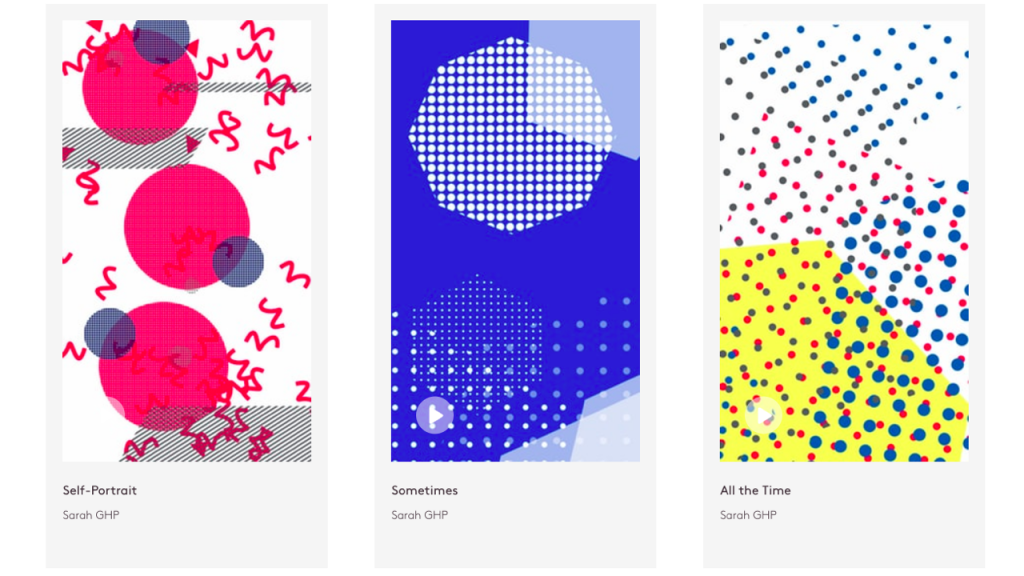
In her presentation, she begins with telling the audience her disappointment in how info and data have become big concerns in life as authoritarian forces and big companies constantly extract information from citizens using high technology. She condemns this the lack of privacy and believes that information, data, computers, and high technology should not threaten people’s identity safety and negatively influence our life in general. Thus, she proposed the idea of undermining computing. She explains that this is not to oppose computers as “destroy computer and we will live in the woods”. Instead, she suggests that we should simply take a step back and explore different ways of handling technology. I think her idea is very interesting so I’m looking forward to see how Sarah manages to incorporate this concept in her works. Sarah brings up an alarming problem that we all face in the 21st century. It is constantly debated and argued that what should be the ideal relationship between humans and computers. Sarah moves on by introducing her projects. She has been performing live visuals with her algorithmic band, Codie. They have given performances which involves live coding, dance, and music at multiple locations. I think it’s amazing that by combining dance, music, and visuals, and have them modified alive, Sarah and her band create art pieces that use technology partially but not entirely rely on it. Instead, human is a crucial aspect of all these works and technology is more like a tool. It allows human creativity, participation, intervention, and individuality. Sarah presents some of their performance videos. They have been including pop geometry, adding different features, and accumulating random movements of bits and pieces with people dancing to the party music in the background.They are also accepting human failures and making failures interesting as sometimes the program gives them surprising results when there are errors.
Sarah explains that AI art is usually futuristic, magic, and novel. People spend too much effort expressing how fascinating a futuristic, high-tech world is yet ignore the fact that human behaviors can be equally valuable and interesting.
Looking Outwards 08: The Creative Practice of an Individual
Brian House, https://brianhouse.net/
Brian House is a new media and interdisciplinary artist whose work focuses on computational and artistic representations of time and location. He has studied computer science and computer music at Columbia University, Brown University, and Chalmers University of Technology. House is originally from Colorado, but is based in Portland, Oregon as a teaching professor at Lewis and Clark College. One project of interest and representative of House’s body of work, which he emphasized during his talk at the 2018 Eyeo Festival, is Animas.
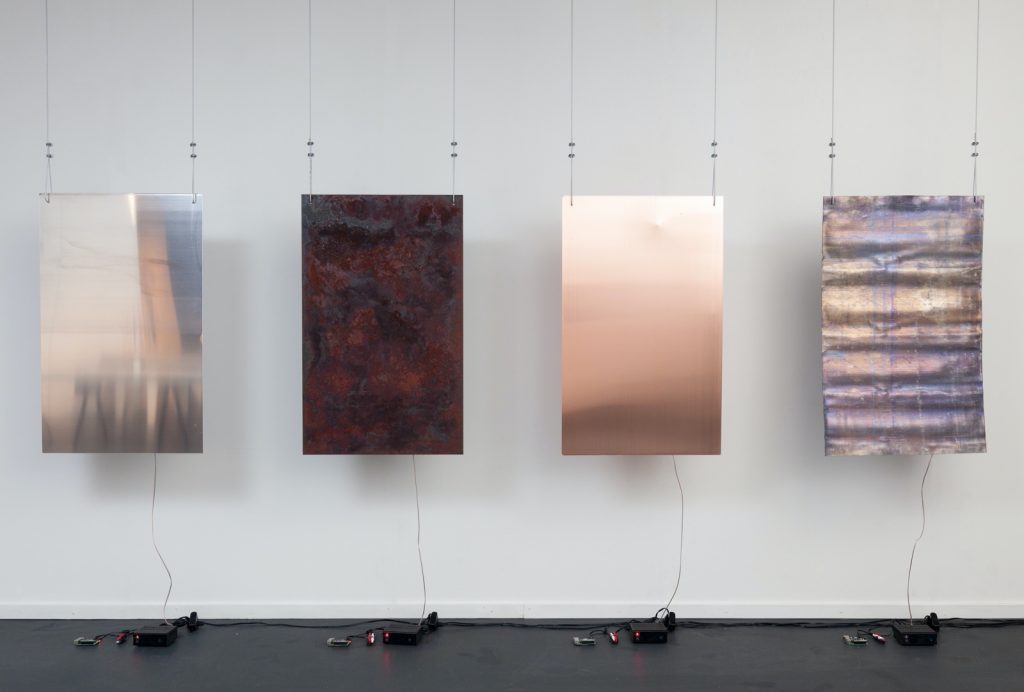
To address the issue of water contamination in the Animas River, he created panels of the metals exceeded EPA tolerances in the river. They vibrated at unique frequencies which updated based on real-time data. The changing makeup of the river generated a unique sound composition. I appreciate that his body of work takes political issues and uses sound, new, and time-based media to make thought-provoking work. I thought he was a very engaging speaker in that he outlined some of his more representative works within his speech and contextualized each of them within society and human relationships, making them more relatable and engaging.
![[OLD FALL 2020] 15-104 • Introduction to Computing for Creative Practice](../../../../wp-content/uploads/2021/09/stop-banner.png)